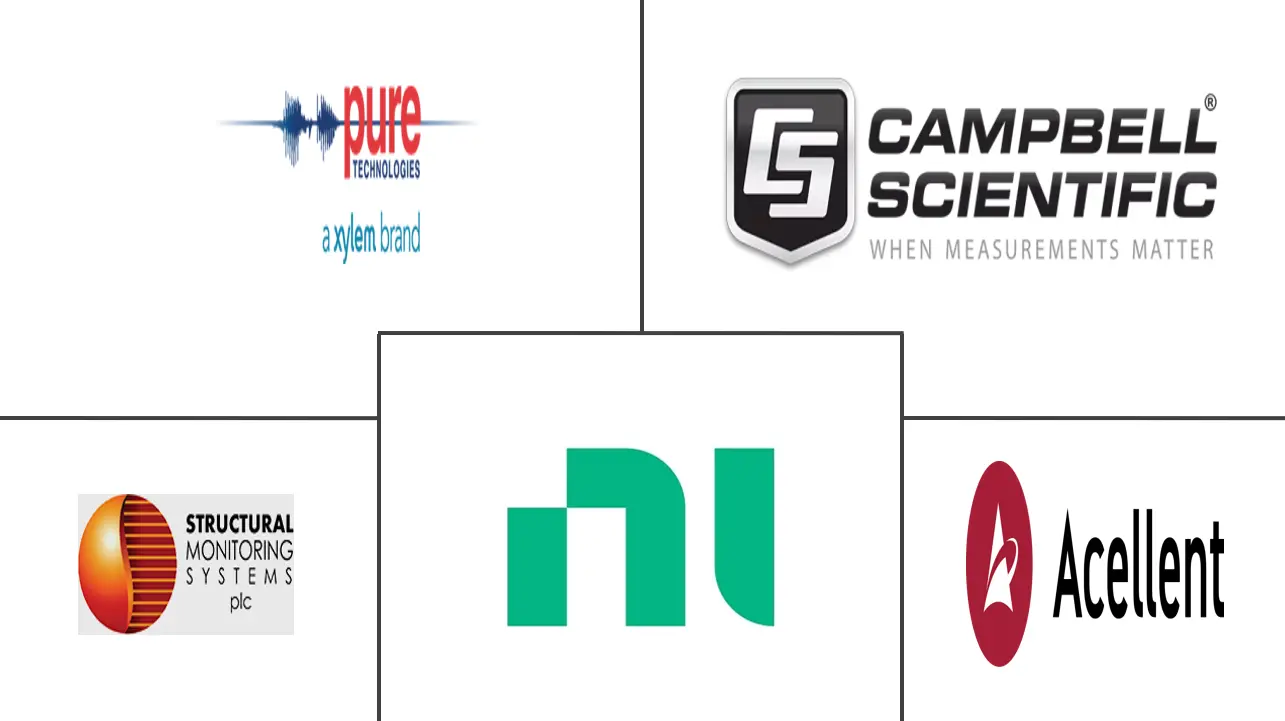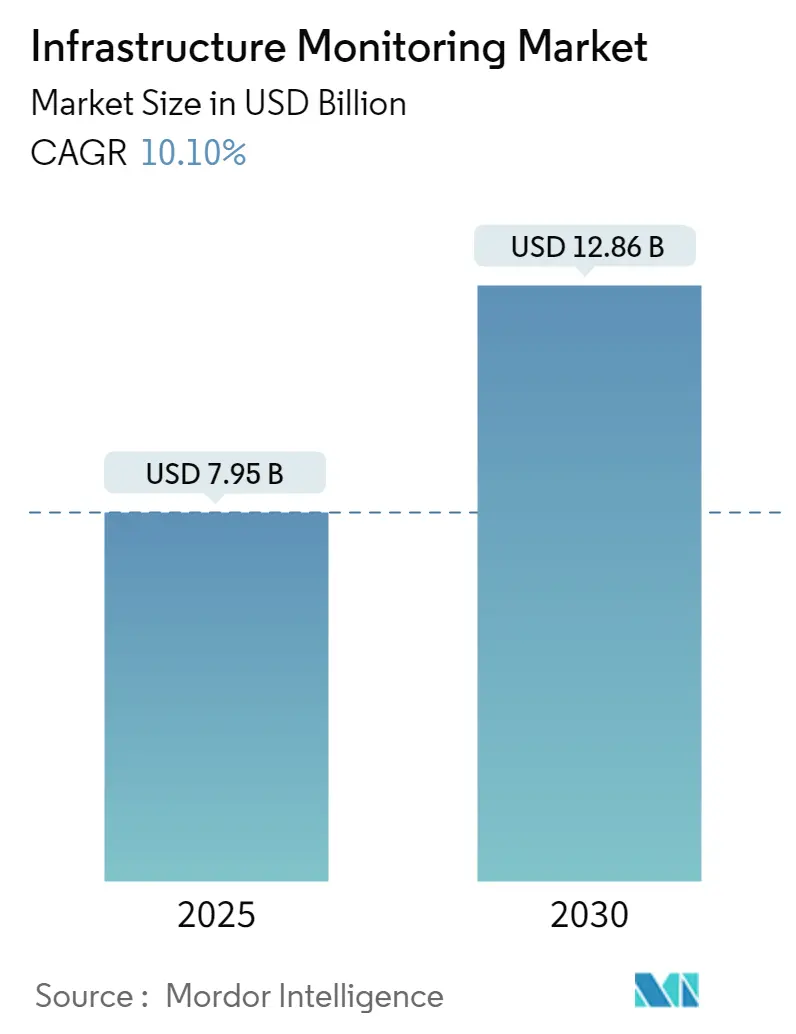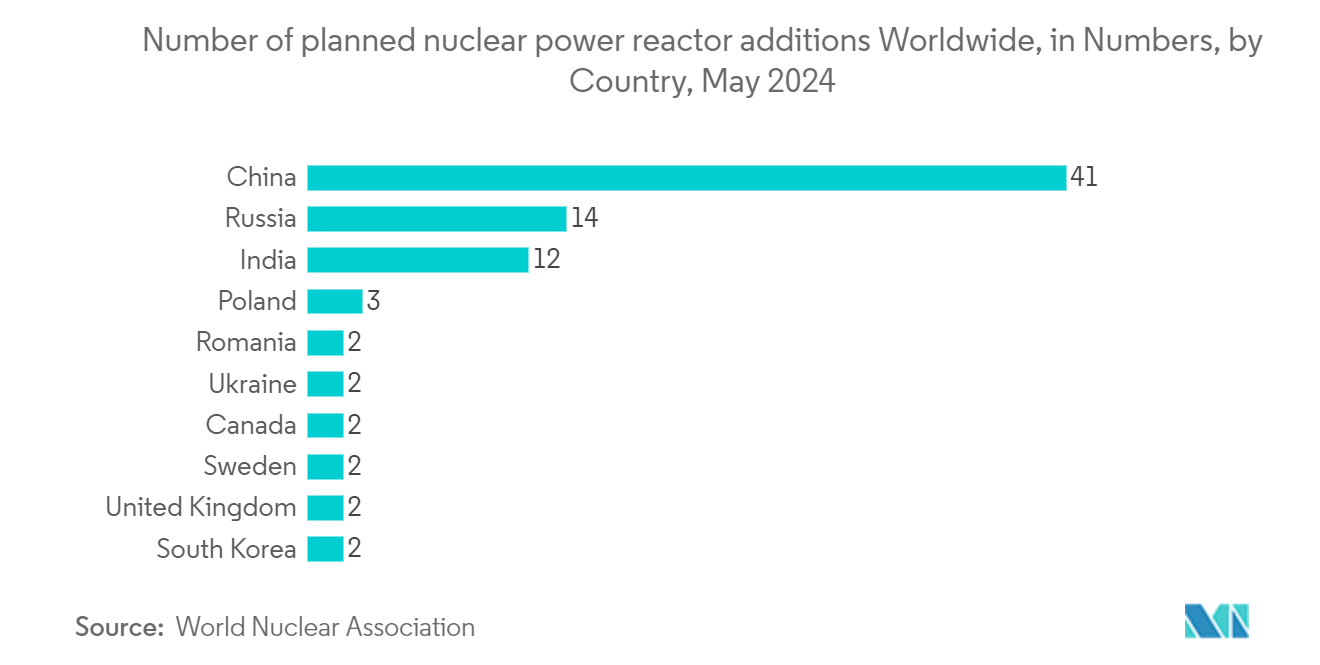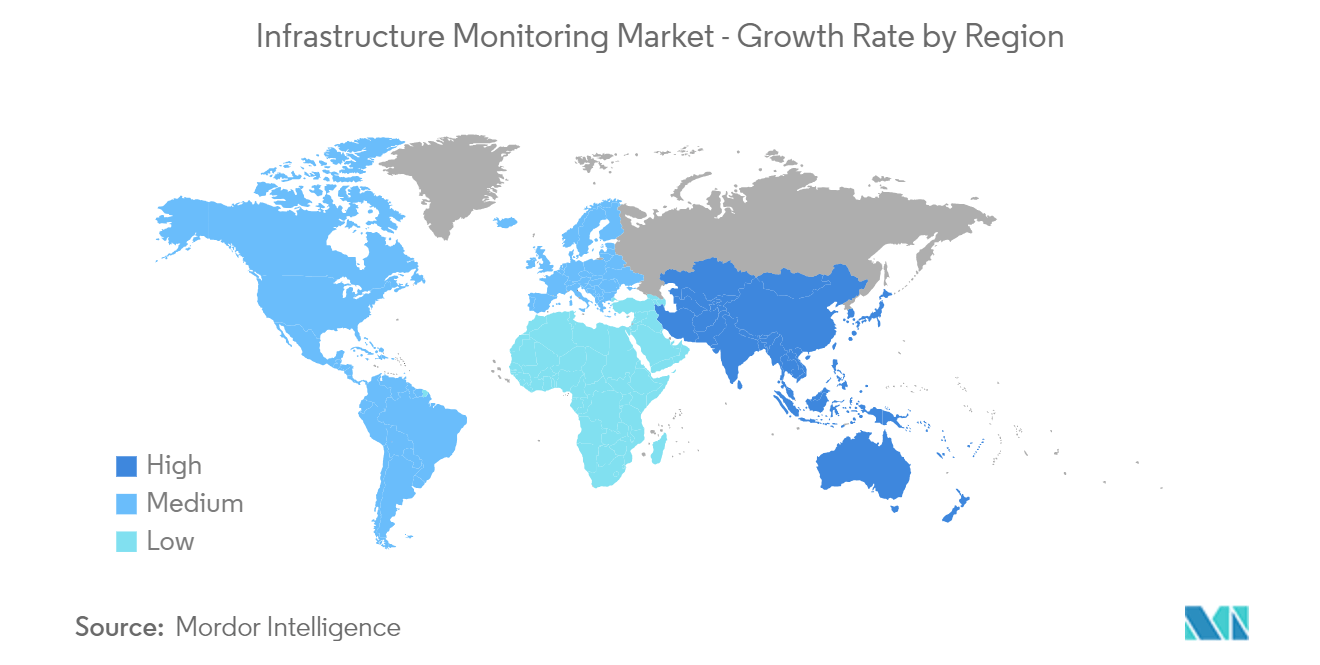Infrastructure Monitoring Market Analysis
The Infrastructure Monitoring Market size is estimated at USD 7.95 billion in 2025, and is expected to reach USD 12.86 billion by 2030, at a CAGR of 10.1% during the forecast period (2025-2030).
- The growing use of advanced sensor technologies, declining cost of sensors, growing demand for preventive maintenance, and increasing capital investments to ensure better maintenance of critical infrastructure across the end-user industries are driving the growth of the infrastructure monitoring market.
- The growing demand for predictive maintenance to reduce life cycle maintenance costs is one of the primary drivers of this industry. The MEMS (Micro electro mechanical systems) inertial sensors are extensively used in predictive condition monitoring of buildings, production systems, and even vehicles. This has been further augmented by the emergence of IoT and advanced analytics that continually improve such systems' functionality.
- In February 2022, New Relic, the observability company, declared the general availability of a new infrastructure monitoring experience especially to empower SRE, DevOps, and ITOps teams to proactively resolve and identify issues in their private, public, and hybrid cloud infrastructure. The modernized experience mainly enables engineers to instantly isolate bottlenecks by sorting and filtering based on key golden signal conditions, analyze all related telemetry (including events, logs, network, alerts, etc.) in context, visualize blast radius with topology maps and perform historical analysis to understand the various cascading impacts.
- Moreover, the ability to remotely monitor critical infrastructure using smart sensors has led to the proliferation of the market. This is extremely helpful in the end-user segments, like mining, where structural monitoring using smart sensors enables companies to save money and lives. Inertial sensors from First Sensor that can achieve resolutions of 10 µg or 0.0005° (2 arc seconds) are extensively used for remote monitoring of buildings, bridges, and wind turbines.
- Ground-penetrating radar (GPR) is also growing in importance because of its cost advantages. It is increasingly being used for bridge and tunnel inspections, roadway investigations, and to ensure adequately compacted asphalt on roads. For instance, by utilizing the GPR technology, Kentucky Transportation Center found the location of large voids in the Cumberland Gap Tunnel, which links Kentucky and Tennessee. It also significantly reduced the repair costs by using GPR to confirm that no voids needed to be fixed on one end of the tunnel.
- However, the high-cost involvement, especially in implementation and deployment, might be a significant matter of concern that can hamper the overall market's growth throughout the forecast period.
- During the COVID-19 pandemic, the companies operating in the Infrastructure Monitoring market faced temporary operative issues due to the absence of site access and disruption in the supply chain, which negatively affected the market's growth. Various associations, including those that provide multiple certifications, have also taken a hit. However, companies such as Bureau Veritas reported a 900% rise in demand for the remote inspection of offshore assets and equipment since the pandemic outbreak.
Infrastructure Monitoring Market Trends
Energy Sector is Expected to Account for a Significant Share of the Market
- The energy segment is anticipated to get significant traction in the infrastructure monitoring market owing to the increasing demand for improving energy efficiency, sustainability, and cost-effective practices. Additionally, the growing importance of timely and predictive maintenance for energy sector assets provides a promising future for the growth of infrastructure monitoring in the energy sector.
- Further, the remote maintenance benefits that the Structural Health Monitoring Systems offer is extremely beneficial for both onshore and offshore systems in this sector. In a wind turbine, for instance, central data modules are being increasingly used to transmit data related to various structural conditions. Moreover, the introduction of cloud solutions has enabled this structural health monitoring data to be continually collected and evaluated for predictive maintenance. Most wind farm operators leverage Supervisory control and data acquisition (SCADA) data for remote monitoring and management.
- Moreover, Structural Health Monitoring solutions led to substantial cost savings through early detection, thereby facilitating higher investment in future predictive maintenance solutions. Duke Energy deployed Schneider Electric's Avantis PRiSM technology to save over USD 7.5 million through early crack detection in a turbine rotor. This has ensured the prevention of cost overruns through asset optimization and maintenance.
- In addition, non-invasive structural monitoring remains highly critical to the nuclear energy sector, which, by design, supports such technologies. The sensors in nuclear reactors are installed during concrete casting or by inserting them into holes that are drilled into the existing structures. Hence it requires monitoring and maintenance, especially for proper functioning and operations, thereby facilitating the market's growth significantly.
- Moreover, as per World Nuclear Association, as of May 2022, globally, there were 95 nuclear reactors planned worldwide. China recorded the largest figure with 33 units., followed by Russia and India with 27 and 12. Further, as nuclear power plants age, maintenance's importance increases, which is expected to create market opportunities for the market studied.
Asia-Pacific is Anticipated to Grow at a Significant CAGR
- The rapid expansion of the end-user industries that have major avenues for the application of structural health monitoring systems is leading to the expansion of the market in the region. For instance, according to World Nuclear Association, the Asia-Pacific region is witnessing significant growth in terms of electricity generating capacity and specifically nuclear power. The region is home to about 135 operable nuclear power reactors, and about 35 are under construction, with the fastest growth in nuclear generation expected in China. Thus, the need for maintenance of those power plants will also increase, which in return will create a market for structural monitoring.
- The application of infrastructure monitoring equipment within Aerospace and Defense is further driving the market. For instance, according to the Stockholm International Peace Research Institute (SIPRI), China and India have enhanced their nuclear arsenal over the last year. The Swedish think-tank pointed out that China is significantly modernizing its nuclear arsenal. According to the SIPRI Yearbook 2022, as of January 2022, China, Pakistan, and India have 350 165 and 160 nuclear warheads, respectively. Such existence mandates the need to monitor them so that they don't fall into the wrong hands.
- Further, with the development of smart cities, China has established more than 700 innovative city projects in more than 500 cities, covering big and small cities. The concept of smart city development has been incorporated in the 14th Five Year Plan (2021 to 2025) development goals of nearly all Chinese provinces and regions. With the acceleration of urbanization in China, smart city, as the internal realistic demand of urban development, has become the new wave of urban informatization.
- Moreover, there has been an increased count of aging infrastructure in China, making it essential for the usage of infrastructure monitoring services to identify and secure the integrity of these structures. As a result, the deployment of these solutions in the country is expected to grow rapidly over the forecast period due to the increasing need to conduct periodical assessment operations to preserve aging infrastructure and the need to optimize infrastructure expenses.
- Additionally, growing smart city projects are expected to provide opportunities for the growth of the market in the country. For instance, In India, The Smart City Mission is scheduled to be finished in 2023. Prime Minister Narendra Modi declared the initiative back in June 2015, and the Centre chose 100 cities from across India to participate. These cities will be developed to provide citizens with access to core infrastructure, a healthy and sustainable environment, and a decent standard of living using smart solutions. The mission's implementation timeline was extended till June 2023, making 2023 one of the most important years for India's Smart Cities.
Infrastructure Monitoring Industry Overview
The competitive landscape of the infrastructure monitoring market remains fragmented, with several small and medium-sized players operating in the market. The evolving needs of the end-user segments are driving the market vendors to offer innovative products. In addition, growing opportunities in the market are attracting new players and investments in the market.
- September 2022 - Equinor and Norwegian technology Vissim have completed the development of a new and expanded ocean space surveillance system for energy operators on the Norwegian and UK continental shelves. The new and expanded ocean space surveillance system incorporates subsea infrastructure monitoring, marine planning through weather forecasts and real-time monitoring, and 3D situational awareness.
- January 2022 - Netreo announced that both the Netreo full-stack IT infrastructure monitoring and Retrace by Netreo full lifecycle APM solutions earned Veracode Verified Standard recognition proving that code development processes meet AppSec best practices and further boosting the security posture of the Netreo and Retrace by Netreo solutions.
Infrastructure Monitoring Market Leaders
-
National Instruments Corporation
-
Pure Technologies Ltd. Company (Xylem Inc.)
-
Campbell Scientific, Inc. Company
-
Structural Monitoring Systems plc
-
Acellent Technologies, Inc.
- *Disclaimer: Major Players sorted in no particular order
Infrastructure Monitoring Market News
- June 2024: Neilsoft, a provider of engineering services and software solutions (ER and D) to global clients in the AEC/construction, manufacturing, and industrial plant sectors, has launched its new SaaS solution, ConstructMonitor. Developed in partnership with Tokyo-based Fujita Corporation, this solution addresses quality management challenges in large-scale construction projects, including commercial offices, high-rise buildings, data centers, hospitals, industrial plants, factories, malls, IT parks, and other infrastructure projects.
- June 2024: proteanTecs, a global firm in health and performance monitoring solutions for advanced electronics, has introduced RTSM (Real-Time Safety Monitoring). This deep data application aims to detect faults and prevent failures in mission-critical automotive applications. The rapid evolution of automotive architectures, driven by the rise of software-defined, electric, and autonomous vehicles, has led to the incorporation of advanced electronic systems and complex semiconductor technologies.
Infrastructure Monitoring Industry Segmentation
Infrastructure monitoring involves gathering and analysing data from IT systems, processes, and infrastructure in order to enhance business outcomes and provide value for the entire organisation.
The infrastructure monitoring market is segmented by technology (wired, wireless), offering (hardware, software and services), end-user industry (mining, aerospace and defense, civil infrastructure, energy), and geography (North America, Europe, Asia-Pacific, Latin America, Middle East & Africa). The market sizes and forecasts are provided in terms of value (USD) for all the above segments.
| By Technology | Wired |
| Wireless | |
| By Offering | Hardware |
| Software and Services | |
| By End-user Industry | Mining |
| Aerospace and Defense | |
| Civil Infrastructure | |
| Energy | |
| Other End-user Industries | |
| By Geography*** | North America |
| Europe | |
| Asia | |
| Australia and New Zealand | |
| Latin America | |
| Middle East and Africa |
Infrastructure Monitoring Market Research FAQs
How big is the Infrastructure Monitoring Market?
The Infrastructure Monitoring Market size is expected to reach USD 7.95 billion in 2025 and grow at a CAGR of 10.10% to reach USD 12.86 billion by 2030.
What is the current Infrastructure Monitoring Market size?
In 2025, the Infrastructure Monitoring Market size is expected to reach USD 7.95 billion.
Who are the key players in Infrastructure Monitoring Market?
National Instruments Corporation, Pure Technologies Ltd. Company (Xylem Inc.), Campbell Scientific, Inc. Company, Structural Monitoring Systems plc and Acellent Technologies, Inc. are the major companies operating in the Infrastructure Monitoring Market.
Which is the fastest growing region in Infrastructure Monitoring Market?
Asia Pacific is estimated to grow at the highest CAGR over the forecast period (2025-2030).
Which region has the biggest share in Infrastructure Monitoring Market?
In 2025, the North America accounts for the largest market share in Infrastructure Monitoring Market.
What years does this Infrastructure Monitoring Market cover, and what was the market size in 2024?
In 2024, the Infrastructure Monitoring Market size was estimated at USD 7.15 billion. The report covers the Infrastructure Monitoring Market historical market size for years: 2019, 2020, 2021, 2022, 2023 and 2024. The report also forecasts the Infrastructure Monitoring Market size for years: 2025, 2026, 2027, 2028, 2029 and 2030.
Our Best Selling Reports
Infrastructure Monitoring Industry Report
Statistics for the 2025 Infrastructure Monitoring market share, size and revenue growth rate, created by Mordor Intelligence™ Industry Reports. Infrastructure Monitoring analysis includes a market forecast outlook for 2025 to 2030 and historical overview. Get a sample of this industry analysis as a free report PDF download.







